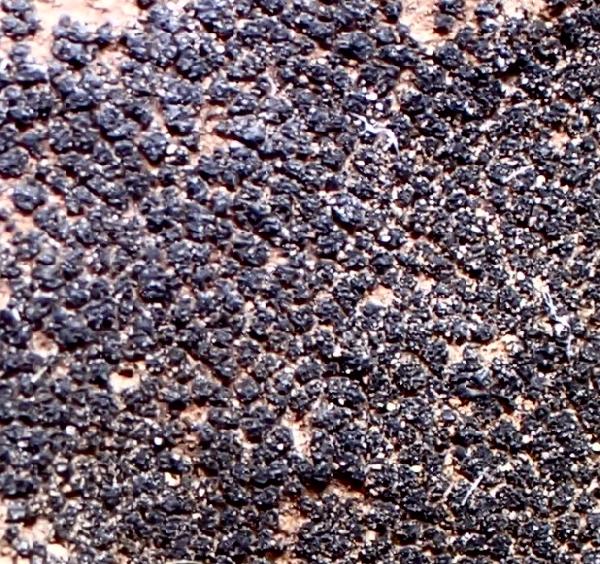Lichinella myriospora (Zahlbr.) P.P. Moreno & Egea ex M. Schultz
Bryologist, 108, 4: 582, 2005. Basionym: Psorotichia myriospora Zahlbr. - Ann. Mycol., 1: 355, 1903
Synonyms:
Distribution: N - Emil (Ravera & al. 2022b).
Description: Thallus crustose, black, dull, gelatinous when wet, granulose to irregularly areolate, the areoles flat to slightly convex, up to 0.3 mm wide and 0.1-0.2 mm thick, attached by rhizohyphae, forming up to 3 cm wide patches. Thallus structure homoiomerous, densely reticulate to paraplectenchymatous with short mycobiont cells measuring 3-7.5 x 2.5-3 µm. Apothecia thallinocarps, hemiangiocarpous, the ascogonia arising freely beneath the thallus surface, finally filling the entire areoles and hence inconspicuous, 1(-2) per areole, immersed to semi-immersed, 0.12-0.25(-0.3) mm wide, slightly to rather strongly convex or with a depressed center, with a rough disc and an indistinct, not prominent, c. 50 µm wide thalline margin. Proper exciple absent; hymenium colourless, not separated into partial hymenia, although packets of sterile tissue may intrude between the asci, 70-80 µm high, K/I+ blue rapidly turning reddish brown; subhymenium colourless, K/I+ blue. Asci 16-24(-32)-spored, subcylindrical to obclavate, prototunicate, with a thin, one-layered, non-amyloid wall, an amyloid external apical cap, and passive spore discharge via apical rupturing, Lichina-type. Ascospores 1-celled, hyaline, broadly ellipsoid, 5-7.5 x 2.5-4 µm. Photobiont cyanobacterial, chroococcoid, the cells single or paired, enclosed in yellowish brown gelatinous sheaths. Spot tests: all negative. Chemistry: without lichen substances.Note: this species, with a scattered distribution across southwestern and southeastern Europe, Mongolia and North America (Schultz 2007, Candan & Schultz 2015), grows on calciferous rocks, sometimes on mineral soil, in sun-exposed, dry sites. The species is closely related to Psorotichia suffugiens (which also belongs to Lichinella). The description follows Schultz (2007a).
Growth form: Crustose
Substrata: rocks, soil, terricolous mosses, and plant debris
Photobiont: cyanobacteria, coccaceous (e.g. Gloeocapsa)
Reproductive strategy: mainly sexual
On otherwise dry surfaces with short periods of water seepage after rain
Commonnes-rarity: (info)
Alpine belt: absent
Subalpine belt: absent
Oromediterranean belt: absent
Montane belt: very rare
Submediterranean belt: very rare
Padanian area: absent
Humid submediterranean belt: absent
Humid mediterranean belt: absent
Dry mediterranean belt: absent

Predictive model
Herbarium samples

Arizona State University Lichen Herbarium (ASU:Lichens) – Determiner: Garry Neil (24-01-2021)
Collector: Garry Neil Number: 500 Date: 2020-04-30 Locality: United States, Arizona, Yavapai, Transept Trail, Red Rock Ranger District, Red Rock Ranger District; 34.790756 -111.789436
34.790756 -111.789436 Elevation: 1298 m Habitat: Front SW side of a sandstone cliff face, totally exposed, within a piñon-juniper woodland Substrate: rock - CC BY-NC 3.0 - Source: Consortium of Lichen Herbaria (2023) http//:lichenportal.org/portal/index.php. Accessed on December 18.
Growth form: Crustose
Substrata: rocks, soil, terricolous mosses, and plant debris
Photobiont: cyanobacteria, coccaceous (e.g. Gloeocapsa)
Reproductive strategy: mainly sexual
On otherwise dry surfaces with short periods of water seepage after rain
Commonnes-rarity: (info)
Alpine belt: absent
Subalpine belt: absent
Oromediterranean belt: absent
Montane belt: very rare
Submediterranean belt: very rare
Padanian area: absent
Humid submediterranean belt: absent
Humid mediterranean belt: absent
Dry mediterranean belt: absent

Predictive model
| Herbarium samples |

 Index Fungorum
Index Fungorum
 GBIF
GBIF

